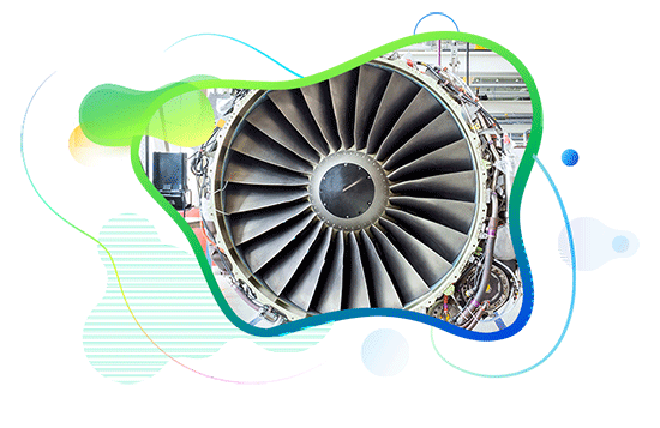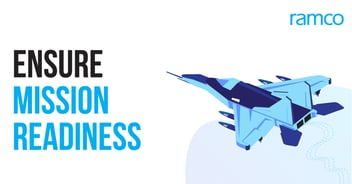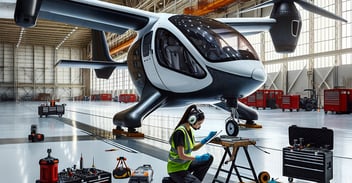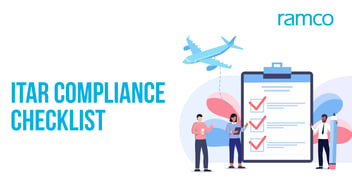
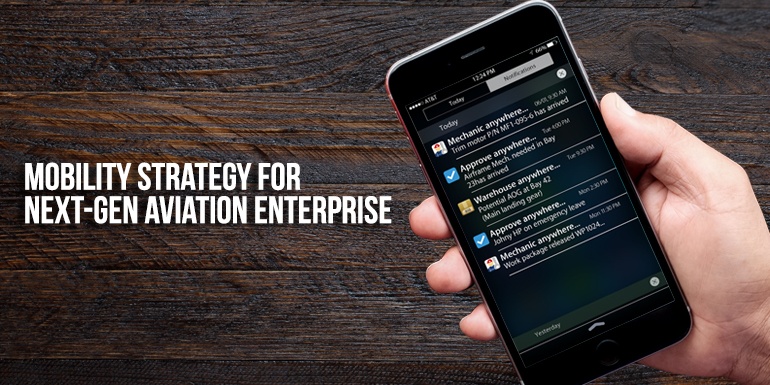
Aviation industry has been constantly revolutionized for over a century resulting in the current air transport system. It is dominated by new operating models, innovative entrants which creates intense competitive pressure for legacy companies. The future success of the industry will be decided, in part, by its ability to harness new-age technologies to deliver desired customer experience while empowering employees and improving operational efficiencies. The timing is perfect, as new products and innovations in mobility are emerging as one of the most promising avenues for airlines to transform their business operations. Mobile computing is making waves in the aviation MRO industry just like it has revolutionized the mass consumer market. However, unlike the mass consumer market, where acquiring the latest gadget is cool, many in the MRO industry are taking a more cautious approach. The MRO mobility strategy is a function of three variables;
- User context
- Device Size
- Mobile Applications
From the User-context, we can broadly divide the adaptation of mobile devices and the applications into three periods based on the use-case and user perspective. The timeline of these periods is quite blurred as the pace of technology changes has been too rapid to make a reasonable distinction. However to keep it simple we could safely say that the first period of adaptation began in early 2013. The second period began in late 2014 and the third is yet to come. In 2013, the mobile devices were looked upon as agents of information delivery to the line, hangar or shop personnel. Companies like JetBlue Airways were using the mobile devices to access information such as troubleshooting guidelines, work scopes and parts illustrations. Companies like ATP were able to capitalize on their existing library of manuals and provide a mobile application to access different manuals on a mobile device. In this period, information was largely flowing only in one way. In early 2014, ERP companies began to develop and provide mobile solutions which would not only access information from the backend but also route information back to the backend. This means that when a mechanic enters information about a maintenance action, the data is processed and stored in the enterprise software. Obviously a lot of analysis could be done on such data, based on various parameters, leading to more reliable maintenance actions in the future.
I mentioned a third period earlier, which is yet to come, and this will broadly align with the focus of the new generation enterprise software systems; Automation is the key to improving productivity and reducing the cost factor. Mobility applications and their devices will then form an integral part of the automation strategy. We at Ramco Systems are carefully studying the various possibilities of user contexts requiring automation and trying to innovate and align itself with this goal. As a step towards this futuristic process, our solution is now available in wearable technologies like smart watch and Google glass. Aviation industry has now begun to look at independent software service providers as partners in innovation. One such example is the latest announcement by Air France Industries KLM regarding a co-innovation center in Singapore in partnership with Ramco systems. I quote verbatim from the press release; “The MRO Lab Singapore aims to encourage the rapid emergence and diffusion of innovative, high value-added, MRO solutions, in the heart of a fast growing MRO market and in a fruitful innovation ecosystem.”
The second important variable of your mobility strategy is the device size. There are a lot of mobile vendors in the market who are all pushing their own unique devices with various sizes. Ease of use, location of use, portability and wifi or data connectivity will determine the size of the device most appropriate to a user context. Here then is a complication as the device users cannot be using too many different size devices based on their requirements. Companies would have to adopt optimum size devices which would cater to a broad range of user contexts.
Mobile applications, which are the third variable in the strategy, would then have to be developed based on the size of the device as well as the user contexts. The size of the device is important as the user interfaces of the application would have to be optimized for a particular device. A sub-variable of the application is the type of mobile application you need to develop. There are three types of applications in the mobile realm; Native application, web application and hybrid application. Native applications live on the device and are installed through an application store. Web applications are web pages modified for the device and hybrid applications are a combination of native and web applications. Each of these has its own advantages and disadvantages. Some of the advantages of a native application are speed, advanced user experience, access to other features of the device such as biometric sensor, accelerometer and camera and offline operation. Also, in native applications, the interface can be created for target users.
Taking the above mentioned variables into consideration and after due consultations with the field experts and stakeholders, Ramco Systems has embarked on providing a next-gen mobile strategy for its customer base. Ramco has collaborated with its customers to launch Anywhere Apps on mobile for Mechanics, Supervisors, Customers, Pilots & Storekeepers. Let me give you a quick brief on each of the apps. The “Mechanic Anywhere” application simplifies the daily operations of a line Mechanic / Engineer. The application directs the mechanics/supervisors to know pending / next actions through an intuitive dashboard and enables the line mechanic to perform scheduled maintenance activities and also record defects over an ‘E-Log’ on the fly. While carrying line maintenance actions, the app facilitates the line mechanic to request parts, perform component replacements, labour recording, parts consumption, discrepancy reporting, review attachments & perform sign off at ease through smart and touch actions. Likewise, the “Warehouse Anywhere” application simplifies the warehouse / stores processes. The application directs the warehouse manager or the store clerk to know pending / next actions through intuitive dashboard and enable them to act upon the material request, quick picking and confirmation of parts through smart & swipe actions. Key features in the app such as quick parts issue, part transfer, stock inquiry, geo-fencing promotes usability to perform business functions in a faster and timely manner.
“Approve Anywhere” enables requisition managers to approve anything anywhere anytime on the fly. The application fastracks the approval process facilitating the managers to approve POs, Part Requests, Invoices etc. while not at desk. “Fly Anywhere” application designed for Pilots is the Electronic Flight bag solution on iPad enabling the Pilot to perform all flight management activities such as Pre-Flight, Post-Flight & In-Flight. “Customer Anywhere” aids strengthen your Customer relationship. Yes! Your customers can now track progress of order status, aircraft maintenance progress & many more in real time onboard a mobile application.
With user experiences tailored specific to the company, these apps are the go-to solutions empowering your employees while creating the quantum shift that will declare you the winner. Feel free to contact us at contact@ramco.com to know more about Ramco Aviation Mobility Solutions.
Frequently Asked Questions (FAQs)
Enterprise asset management (EAM) involves the management of mission critical assets of an organization throughout each asset's lifecycle. EAM is used to plan, optimize, execute, and track the needed maintenance activities with the associated priorities, skills, materials, tools, and information. The aim is to optimize the quality and utilization of assets throughout their lifecycle, increase productive uptime and reduce operational costs.
Enterprise asset management (EAM) involves the management of the maintenance of physical assets of an organization throughout each asset's lifecycle. EAM is used to plan, optimize, execute, and track the needed maintenance activities with the associated priorities, skills, materials, tools, and information.
The software helps in effective maintenance of assets through preventive, predictive, shutdown and breakdown maintenance strategies. The system also helps enterprises mitigate equipment risks by enhanced safety standards. The streamlined operations and improved asset performance helps organizations increase their investment effectiveness.
EAM is important because it helps organizations track, assess, manage and optimize asset quality and reliability. Asset intensive Organizations have hundreds, thousands, even millions of assets which needs to be maintained to maximize / optimize life of these assets to increase the return on investment.
The key features of effective EAM are:
- Work management.
- Maintenance Strategies (Preventive/ Predictive / Breakdown / Shutdown).
- Planning and scheduling.
- Supply chain management.
- Health and safety.
- Mobility.
- Analytics.
- Improved Asset Health at reduced cost through data driven maintenance Programs
- Complete visibilityon entire maintenance data across Equipment, across Models, across Branches to aid in analysis & decision making such as to Repair or Replace the Equipment
- Insightful analysis of Inspection Data to improve customer satisfaction
- Effective maintenance management enhanced by predictive maintenance and inbuilt analytics
- Increased reliability and safety, keeps complete track of all the inspections & calibration schedules
- Mobile Application enables users to execute work while “in the field” leading to minimized non-productive time and increased productivity and reduces duplication of work and human errors in recording information.
- Quick turnaround time through Actionable Notification & Alerts for every process in real time and accessible anytime and anywhere.
- Improved Regulatory Part of asset management involves the implementation of better O&M practices, which can significantly improve compliance.
Asset Intensive companies under the following Industries :
- Ports
- Cement and Mining
- Utilities
- Fleet Maintenance
- Equipment Rental
- Other Manufacturing
- Real Estate & Infrastructure
- Power Generation
Contact us for a meeting and schedule a demo
This differs on case to case basis, based on the type of installation and unique industry specific requirements. Contact us for a meeting and schedule a demo.
This differs on case to case basis, based on the type of installation and unique industry specific requirements. Contact us for a meeting and schedule a demo.
Stay Connected, follow us on LinkedIn / Twitter to know more about EAM Software latest trends.
